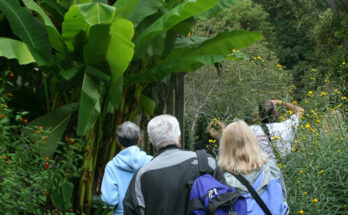The job of hillside landscaping is a problem with more homes built on sites which have major changes in elevation and steep slopes.
Landscaping a hill as gardening trend is likely to continue in cities and suburban areas across the nation as most of the “level sites” are in short supply.
Homeowners have a growing awareness of the dramatic value or curb appeal of landscaped hillside locations in their garden or backyard.
The popularity of home landscape design is evidence enough. Add to that the appreciation of the aesthetic possibilities of landscaping a hillside garden, slopes in backyard and front yard landscaping, small steep hills, rocks and changes of level.
Uneven topography – a slope – however, is an asset only if it is thoughtfully handled.
Landscaping a Slope or Hillside
Are you learning how to landscape on a hill?
Many homeowners have found that gravity and water acting on an improperly planned hillside or slope can require endless maintenance with little resulting reward.
In some cases, the necessary remedy is regrading or installing a retaining wall, in others, merely the proper selection of plants or trees in the garden. Whichever the case, there is no need for discouragement.
Changing The Steep Hillside Landscape
Today with the wide variety of available earth-moving equipment, grade changes are practical from the cost standpoint. Successful planting is possible by using a wide selection of low maintenance hillside landscaping plant materials.
We’ve all seen sand heaped into a pile, seeing it form a mound with sloping sides. The exact slope is determined by the material and will consistently readjust itself each time the sand comes to rest. Clay has one angle of “rest” and silt another.
Any attempt to make a free standing earth bank of any kind of soil steeper than its own particular natural slope is likely to fail through the action of gravity.
A sand castle is illustrative of what can be expected. A child may temporarily defy the forces of nature by tamping and moistening, but sooner or later the walls come tumbling down.
Under conditions of normal sub-surface drainage, it is generally safe to assume that a bank of any type of soil will stand firm against gravity if the surface slope does not drop more than one foot for each two feet of horizontal distance.
This steepness is comparable to that assumed by a plank laid flush along a stairway or steps, having six-inch risers and 12-inch treads.
Related Reading: How To Build A Path On A Slope
The impracticability of steeper slopes is shown by the fact that highway departments try to avoid back slopes which exceed a slope of two to one. It might also be said that a pitch of this slope appears steep.
In fact, the act of lawn care and mowing turf is considered impractical even on lesser slopes. In this case, the steepest limit is a slope with three feet of horizontal distance for each one foot of rise.
How To Landscape A Hillside
In most instances, hillside slopes landscape can be planned in a simple and straightforward manner. Occasionally, however, complications will arise. If insufficient space exists to accommodate a two to one slope, the ideas of retaining walls or a combination of wails and slopes are the answers.
When wet spots are present, slopes must be either flattened further or underground drainage must be installed.
Drainage pipe, placed in gravel filled trenches designed to pick up and carry water to an outlet, is a common way to deal with an anticipated loss in stability due to excess moisture.
The interior stability of slopes has nothing to do with surface erosion. Interior failure is due to gravity, the force which produces caving in or sliding of comparatively large volumes of material.
Hillside Surface Erosion
The factors involved in surface erosion can, for the most part, be considered distinct and seem simple when listed.
1 – The greater the quantity of water permitted to reach a slope at its upper end, the greater is the possible soil erosion. Planned grading, drains and diversion channels at the top of a slope are desirable.
2 – The longer the slope the greater the erosion. This applies in the case of terraces or veranda. Terraces introduced at intervals slow down water and dissipate its scouring potential.
3 – The steeper the slope the greater the erosion. Gentle slopes permit more surface absorption, which, together with a slower rate of water travel, lessens the amount of scouring.
4 – The more impervious the soil the greater the erosion. A good depth of porous soil will increase absorption, thus diminishing the quantity of surface water with a decrease in scouring.
5 – The more polished the surface (the more it is fine-graded to a smooth surface) the greater the surface erosion. Surfaces with a rough texture, even though the sweep of the grade is generally even, will slow down water, in crease absorption and lessen scouring.
If for appearance sake the slope is carefully tailored, a mulch can be applied to protect the surface until permanent plant materials are introduced. Plants and trees increase absorption and prevent scouring.
Although in formal situations one instinctively fashions a slope in the form of a straight line this treatment is somewhat in contrast to slopes found in nature.
The forces that work on all slopes tend, through comparatively long periods, to form a cross section which is softened by curves. Thus slopes untouched by man have cut-back rounded tops and filled in rounded bases.
The result is a natural, pleasing sweep of line. Landscape architecture experts often follow this pattern in informal, naturalistic developments.
In deciding upon a plan of action with regard to a change in earth form several additional points must be considered by landscapers.
Preparations For Hillside Planting
Landscaping ideas for a house built on a hillside or slope does not need to be a problem to the owner. You can tackle the job after carefully studying all angles.
Let’s look at moving soil, grading and the preparations for planting.
1 – Although the cost of moving a cubic yard of soil by mechanical means is low, it is none the less sensible to retain as much of the existing grade as possible, rather than to work completely at cross purposes to site conditions.
2 – It is much more economical to push soil from one place on a property to another rather than have an excess of excavated soil hauled away or to bring more soil to the site. It is best, therefore, to try to strike a balance between cut and fill.
3 – Topsoil, which is valuable, should always be pushed to one side before progressing further so that it may be re-spread when the job is done. Besides the consideration of cost, conservation is a factor here.
4 – The ultimate cost of a slope treatment depends not only on immediate grading outlay, but also on future maintenance expenditures. Continual annoyance and replacement of topsoil and plant materials in the future are likely to follow an effort to get by with insufficient grading in the initial establishment of slopes.
Once a slope has been structurally fashioned in a basically sound manner, it may be maintained that way indefinitely by the use of plant materials.
The only utilitarian value of vegetation is to prevent slopes which already have interior stability from being bullied by water. Plant materials are not effective against the forces involved in the sliding or caving-in of large volumes of material.
Grass is a common ground cover for erosion control. Once established, the grass affords excellent protection, but also requires constant maintenance.
Woody plants offer permanent protection with the advantage of low maintenance effort. Because slopes should be and usually are well drained, trees or plants which withstand dry soil conditions are, for most banks, the safest to use.
Video: Slope Landscaping Ideas
Since it is the surface that needs protection certain types of plants are better than others. Evergreen (Lithodora diffusa plants) and bushy, dense growing plants have the greatest ability to soften the impact of raindrops and prevent soil grains from being splashed down hill.
Perhaps of even greater effectiveness are thicket or mat-forming plants. Plants of this type spread by suckers or root shoots or take root from trailing branches and in this manner bind a sizable area of soil. It is obvious, of course, that rapid-growing species give maximum protection faster than slow growing ones.
11 Design Solutions For Your Sloping Backyard
Sloped plots of land can sometimes be difficult to work with, when constructing one’s outdoor space. However… they also offer a lot of opportunities for creative design.
Here was one family’s unique solution: Fireplace Into Their Sloping Hillside
Joanna from popular resource Houzz discusses a number of available design elements, ranging from the more naturalistic and conservative to the more modern and bold.
Be sure to consider the fact that the landscape can shift very slightly over the course of time, though – more elaborate designs may have to be touched up several decades later. 11 Design Solutions for Sloping Backyards
Source link
Originally posted 2022-07-17 13:31:03.







